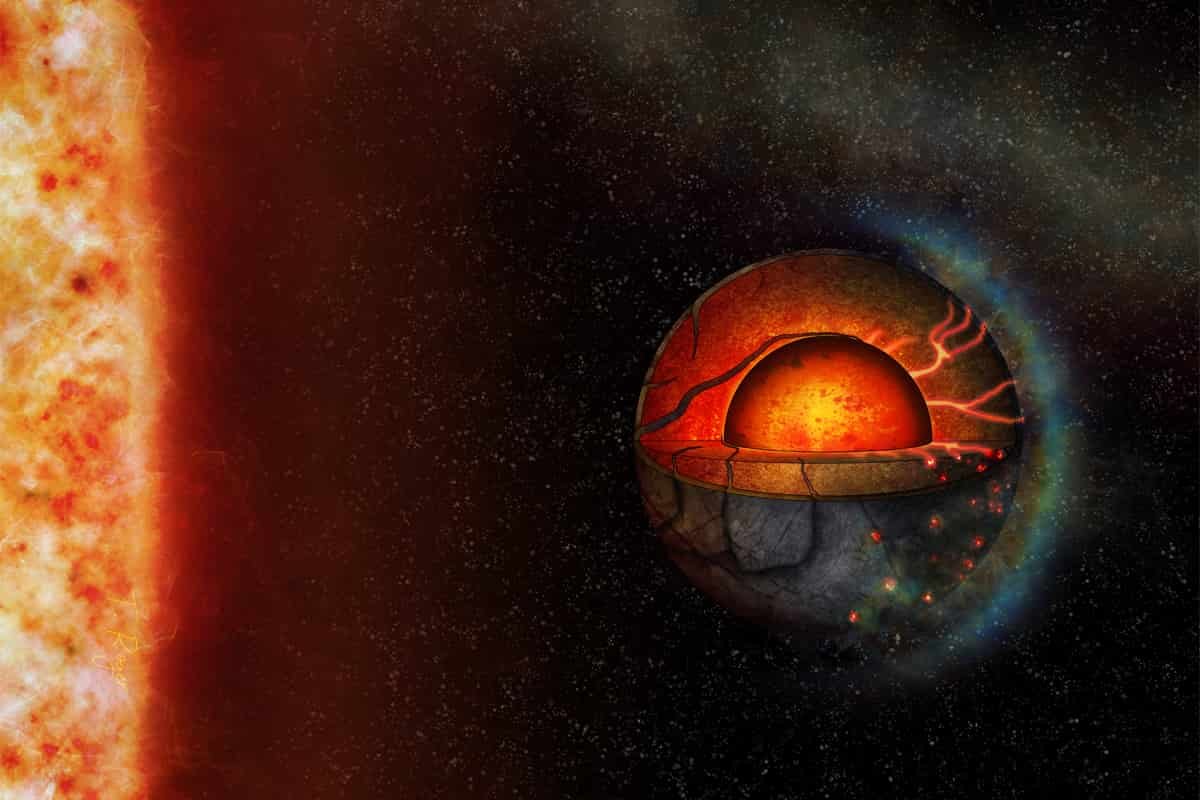Earth Core Cooling
Earth core cooling very fast. Earth’s core freezes and cools at a rate of 1000 tons per second or 100,000 kg (220 462 lbs) in other words more than 31 billion tons of the core freezes every year. Due to the heat that the Earth emits into space, the seed of the Earth’s core is petrified and rises by a millimeter each year.
Every second, the Sun radiates into space and towards our planet a stream of a million tons of protons and electrons: this is called the solar wind. These particles are intercepted by the Van Allen belt, the earth’s magnetic field. This one, which spans more than 70,000 kilometers, is produced by the iron and nickel that make up the Earth’s core. This core consists of a solid, seed, 2,800 kilometers in diameter, surrounded by a liquid layer 2,000 kilometers thick. This continuous stirring of the molten metal layer creates a magnetic field.
The earth is cooling and the core is hardening
Problem: cooling of the Earth’s core has the effect of solidifying the liquid layer on the surface of the seed, at a rate of 10,000 tonnes per second. The seed grows several tens of millimeters per year (that is, 500 kilometers per billion years). When, in a few billion years, the seeds will occupy most of the core, the Earth’s magnetic field will be extinguished. Losing this shield, the Earth will be illuminated by the solar wind.
Future Implications
Dive deeper into the potential consequences of Earth’s core cooling and the eventual extinction of its magnetic field. Consider scenarios where the weakening magnetic shield exposes Earth to increased solar radiation, leading to changes in climate patterns, geological activity, and atmospheric composition. For example, without the protection of the magnetic field, solar wind could strip away Earth’s atmosphere over time, affecting the planet’s habitability. Explore hypothetical timelines for these changes and discuss their significance for the long-term evolution of Earth.
Scientific Perspectives
Provide detailed insights from leading scientists and researchers studying Earth’s core dynamics. Discuss the methodologies and technologies used to study the core, such as seismic imaging, geomagnetic measurements, and computer simulations. Highlight recent breakthroughs in understanding core processes, such as the discovery of new mineral phases under extreme pressure and temperature conditions. Showcase case studies of significant research findings that have reshaped our understanding of Earth’s interior structure and evolution.
Solar System a World Full of Surprises | Composition, Formation and Evolution
Environmental Considerations
Examine the broader environmental implications of Earth’s core cooling and magnetic field decay. Discuss how changes in geomagnetic activity may affect wildlife behavior, including the navigation of migratory birds, sea turtles, and marine mammals. Explore potential impacts on global weather patterns, including shifts in precipitation, temperature, and storm intensity. Additionally, discuss the potential effects on human societies, such as disruptions to satellite communications, power grids, and GPS navigation systems in the absence of a robust magnetic shield.
By understanding the ongoing processes shaping the Earth’s core and magnetic field, you can gain insight into the dynamic nature of our planet and its relationship with the broader solar system.
Nearest Galaxy and the distance from Milky Way (our galaxy)?
Sources: PinterPandai, New Atlast, Weather, Sci Tech Daily, Science Alert
Photo explanation: this artist’s illustration represents the possible interior dynamics of the super-Earth exoplanet LHS 3844b. The planet’s interior properties and the strong stellar irradiation might lead to a hemispheric tectonic regime. © University of Bern [Universität Bern](CH) Credit: Thibaut Roger.
Coldest Cities in the World: Exploring Extreme Winter Climates



